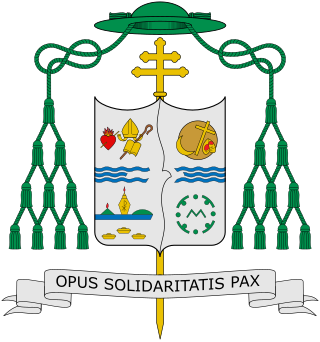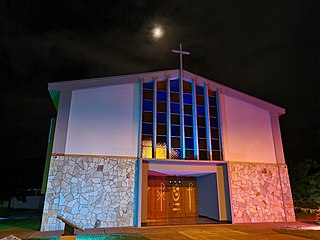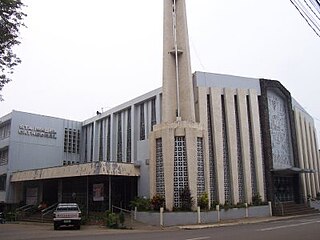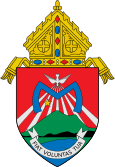
A prelate is a high-ranking member of the Christian clergy who is an ordinary or who ranks in precedence with ordinaries. The word derives from the Latin praelatus, the past participle of praeferre, which means 'carry before', 'be set above or over' or 'prefer'; hence, a prelate is one set over others.
Personal prelature is a canonical structure of the Catholic Church which comprises a prelate, clergy and laity who undertake specific pastoral activities. The first personal prelature is Opus Dei. Personal prelatures, similar to dioceses and military ordinariates, were originally under the governance of the Vatican's Congregation for Bishops. Since 4 August 2022, personal prelatures have instead been governed under the Dicastery for the Clergy. Personal prelatures are composed of lay people served by their own secular clergy and prelate. Unlike dioceses, which cover territories, personal prelatures—like military ordinariates—take charge of persons as regards some objectives irregardless of where they live.

The Territorial Prelature of Batanes is a Latin rite pre-diocesan, non-missionary jurisdiction of the Roman Catholic Church. It is a suffragan in the ecclesiastical province of the Roman Catholic Archdiocese of Tuguegarao on Luzon island in the Philippines.
A territorial prelate is, in Catholic usage, a prelate whose geographic jurisdiction, called territorial prelature, generally does not belong to any diocese and is considered a particular church.

The Archdiocese of Davao is an ecclesiastical jurisdiction of the Catholic Church in the Philippines. It is a metropolitan see in southern Mindanao. The archdiocese comprises the city of Davao, The Island Garden City of Samal, and the municipality of Talaingod, Davao del Norte in Davao del Norte.
A base community is a relatively autonomous Christian religious group that operates according to a particular model of community, worship, and Bible study. The 1968 Medellín, Colombia, meeting of Latin American Council of Bishops played a major role in popularizing them under the name basic ecclesial communities. These are small groups, originating in the Catholic Church in Latin America, who meet to reflect upon scripture and apply its lessons to their situation.

The Archdiocese of Zamboanga is a Catholic archdiocese in the Philippines. Its present jurisdiction includes Zamboanga City, with suffragans in Basilan, Zamboanga Sibugay, and the Apostolic Vicariate of Jolo. It became Mindanao's first diocese in 1910, and was established as the second archdiocese of Mindanao in 1958. Today, the archdiocese covers a land area of 1,648 square kilometers and has a population of 442,345, of which 81 percent are Catholics. The archdiocese includes 28 parishes and one quasi-parish, served by 57 diocesan and 18 religious priests. There are also 51 religious sisters working in the archdiocese.

The Roman Catholic Archdiocese of Cagayan de Oro is an archdiocese of the Catholic Church in the Philippines.

Antonio Javellana Ledesma, is a Filipino Roman Catholic clergyman who served as the Archbishop of the Metropolitan Archdiocese of Cagayan de Oro in the Philippines from 2006 to 2020.

The Roman Catholic Archdiocese of Cotabato is a metropolitan archdiocese of the Latin Church of the Catholic Church on the island of Mindanao, the Philippines. The archdiocese includes North Cotabato and the municipality of Banisilan, Cotabato.

The Roman Catholic Diocese of Cristalândia is a diocese in the ecclesiastical province of Palmas in central Brazil.
The Territorial Prelature of Caravelí is a Roman Catholic territorial prelature in the ecclesiastical province of the Metropolitan of Ayacucho in southern Peru.

The Diocese of Marbel is a Latin Church ecclesiastical jurisdiction or diocese of the Catholic Church in the Philippines.

The Territorial Prelature of Marawi, officially the Prelature of Saint Mary in Marawi, is a Catholic territorial prelature under the Archdiocese of Ozamis in the Philippines.

The Diocese of Ipil is a Roman Catholic Diocese located in the municipality of Ipil in the ecclesiastical province of Zamboanga in the Philippines. It is an ecclesiastical territory in the province of Zamboanga Sibugay. It occupies an area of 4,850 square kilometers extending from the boundary of Zamboanga del Norte on the north to Olutanga Island on the south, from the town of Tungawan on the west to the town Margosatubig on the east boundaries set by Pope John Paul II himself when he decreed the separation of this ecclesiastical territory from the Archdiocese of Zamboanga on December 24, 1979.

The Territorial Prelature of Isabela (de Basilan) (Latin: Praelatura Territorialis Isabellapolitana) is a Roman Catholic territorial prelature located in the province of Basilan, and its component cities of Isabela City and Lamitan City, in the ecclesiastical province of Zamboanga in the Philippines.
Federico O. Escaler, S.J. was a Filipino Prelate of the Roman Catholic Church.

Fernando Robles Capalla was a Roman Catholic archbishop-emeritus of the Archdiocese of Davao. He was succeeded by Romulo Valles as archbishop of Davao on February 11, 2012. He died on January 6, 2024, at the age of 89.

Orlando Beltran Quevedo is a Filipino prelate of the Catholic Church. A cardinal since 2014, he was Archbishop of Cotabato from 1998 to 2018. He became a bishop in 1980.
Religious sector opposition against the dictatorship of President Ferdinand Marcos included leaders and workers belonging to different beliefs and denominations.



















